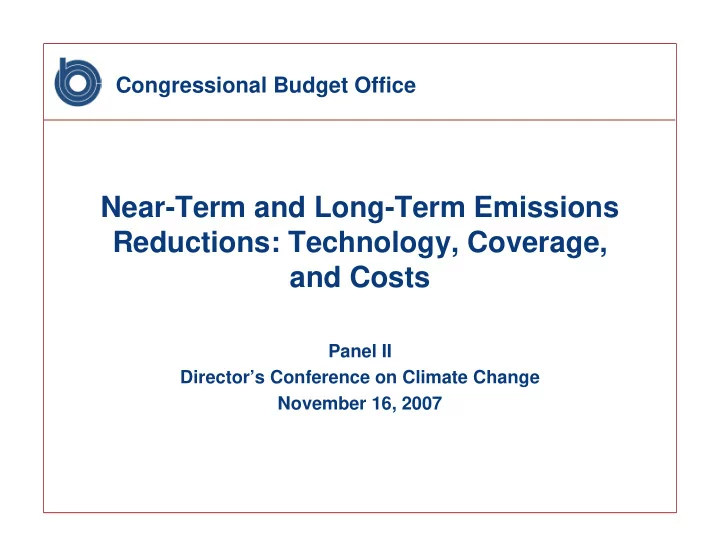

Congressional Budget Office Near-Term and Long-Term Emissions Reductions: Technology, Coverage, and Costs Panel II Director’s Conference on Climate Change November 16, 2007
U.S. Greenhouse Gas Emissions Reductions in 2030 (Not including offsets) $140 MIT Scenarios 2005 Dollars per Metric Ton of CO2 Eq. $120 Lieberman-Warner McCain-Lieberman Bingaman $100 NCEP Policy $80 $60 $40 $20 $- 0% 10% 20% 30% 40% 50% 60% 70% 80% 90% Percent Reduction from Baseline Emissions
What Accounts for the Range of Cost Estimates? Differences in: – How rapidly the economy and emissions are projected to grow (However, projections are similar across the studies, which may understate the range of uncertainty) – How policy is assumed to be implemented: coverage, flexibility in timing of emissions reductions, and so forth – How flexibly households and firms are expected to respond to the policy, and how they discount the future – What technologies are projected to be available at different points in time – What policies other countries are projected to be pursuing Most of the models assume flexible, efficient responses but also largely assume specific technology paths. For both reasons, the full uncertainty in potential costs is probably larger than appears in these figures.
U.S. Greenhouse Gas Emissions Reductions in 2030 (Including offsets) $140 MIT Scenarios 2005 Dollars per Metric Ton of CO2 Eq. $120 Lieberman-Warner McCain-Lieberman Bingaman $100 NCEP Policy $80 $60 $40 $20 $- 0% 10% 20% 30% 40% 50% 60% 70% 80% 90% Percent Reduction from Baseline Emissions
U.S. Consumption Losses in 2030 (Without international offsets) 3.0% Percent Change in Real Personal Consumption MIT Scenarios 2.5% Lieberman-Warner McCain-Lieberman Bingaman 2.0% NCEP Policy Expenditures 1.5% 1.0% 0.5% 0.0% 0% 10% 20% 30% 40% 50% 60% 70% 80% 90% Percent Reduction from Baseline Emissions
U.S. Consumption Losses in 2030 (With international offsets) 3.0% Percent Change in Real Personal 2.5% Consumption Expenditures 2.0% 1.5% 1.0% 0.5% 0.0% 0% 10% 20% 30% 40% 50% 60% 70% 80% 90% Percent Reduction from Baseline Emissions
What Accounts for the Range of Cost Estimates? Near-Term Responses to Regulation (Through 2025): � Energy demand responses are relatively modest � Domestic response tends to be dominated by fuel switching and technology shifts in electricity generation— away from coal and mainly toward natural gas and/or nuclear � Biological sequestration and international offsets could yield significant reductions at relatively modest cost, assuming moderate administration costs and low mitigation effort abroad
What Accounts for the Range of Cost Estimates? Long-Term Responses to Regulation (After 2025): � Offsets become increasingly less important over time, and most reductions come from the energy sector � Technology is critical, but no consensus on what technologies will dominate � There is likely to be a combination of responses: primarily carbon capture and sequestration, nuclear, and biofuels; other renewables and conservation appear to play relatively limited roles
Panel Members Moderator: Robert Shackleton, CBO Speakers: � Francisco De La Chesnaye, Environmental Protection Agency � Howard K. Gruenspecht, Energy Information Administration � Henry D. Jacoby, Massachusetts Institute of Technology � John P. Weyant, Stanford University
References MIT’s Joint Program on the Science and Policy of Global Change Integrated Global System Model, including the Emissions Prediction and Policy Analysis model (ISGM-EPPA) Paltsev et al., Assessment of U.S. Cap-and-Trade Proposals. (http://web.mit.edu/globalchange/www/MITJPSPGC_Rpt146.pdf) Paltsev et al., The MIT Emissions Prediction and Policy Analysis (EPPA) Model: Version 4. (http://web.mit.edu/globalchange/www/MITJPSPGC_Rpt125.pdf) Department of Energy, Energy Information Administration National Energy Modeling System (NEMS) Energy Market and Economic Impacts of S. 280, the Climate Stewardship and Innovation Act of 2007. (http://www.eia.doe.gov/oiaf/servicerpt/csia/pdf/sroiaf(2007)04.pdf) Energy Market and Economic Impacts of a Proposal to Reduce Greenhouse Gas Intensity with a Cap and Trade System. (http://www.eia.doe.gov/oiaf/servicerpt/bllmss/pdf/sroiaf(2007)01.pdf) Environmental Protection Agency, Office of Atmospheric Programs Intertemporal General Equilibrium Model of the U.S. (IGEM), Applied Dynamic Analysis of the Global Economy (ADAGE) EPA’s Analysis of Senate Bill S.280 in the 110th Congress, The Climate Stewardship and Innovation Act of 2007. (http://www.epa.gov/climatechange/downloads/s280fullbrief.pdf) EPA’s Analysis of Senate Bill S.1766 in the 110th Congress, The Low Carbon Economy Act of 2007. (http://www.epa.gov/climatechange/downloads/s1766analysispart1.pdf) National Commission on Energy Policy National Energy Modeling System (NEMS) Economic Analysis of Updated Commission Recommendations (http://www.energycommission.org/files/contentFiles/NCEP_Technical_Appendix_June_2007_4683bf3e2ca9b.pdf) Impacts of the Low Carbon Economy Act of 2007 (http://energy.senate.gov/public/_files/NCEPAnalysisofLowCarbonEconomyAct.pdf) Duke Univsersity’s Nicholas Institute for Environmental Policy Solutions Intertemporal General Equilibrium Model of the U.S. (IGEM), Applied Dynamic Analysis of the Global Economy (ADAGE) The Lieberman-Warner America's Climate Security Act: A Preliminary Assessment of Potential Economic Impacts (http://www.nicholas.duke.edu/institute/econsummary.pdf)
Recommend
More recommend